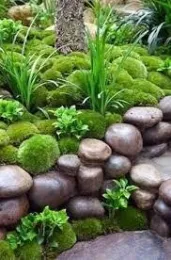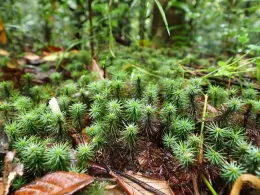Moss. Friend or foe in the garden? It depends.

Moss on a rooftop is not a welcome site for a homeowner. For some gardeners, moss is a delicate plant that provides serenity and beauty in a landscaped garden.
Mosses are small flowerless plants that typically form dense green clumps or mats usually in damp shady places. A closer look will reveal individual plants composed of simple leaves, generally only one cell thick, attached to a stem that may be branched or branchless. But there is much more behind that simple patch of green.
Researchers have learned that moss goes back about 400 million years. Moss is older and lowlier than a fern, but higher and more impressive among life's gardens than algae. Following even the slightest of rain, moss gives an impression of a plant that is lush, velvety green, and vibrant. It can simultaneously be easily cultivated in a home garden or prove to be difficult to grow. Some gardeners find mosses to be more of a nuisance while others find the lush, green plant to be serene and soothing. Mosses don't always grow naturally in the home garden and often can require as much care as any other plant.
Astounding as it may seem, there are upwards of 15,000 species of moss throughout the world with about 1,2000 in North America alone. Some cousins to mosses are lichen, liverworts, and hornworts. Their smallness can be effective in the garden creating a mystical and magical mood.
Mosses are a division of plants known as bryophytes, among the simplest of terrestrial plants and may well be the ancestors of the first plants on earth. Mosses are among the earliest of plants to adapt to living on dry land, having evolved from algae. Although small, they are one of the largest group of land plants in the world existing is a variety of habitats.
Mosses don't have seeds, but use spores to reproduce. They also don't have typical roots like most plants, but anchor

Moss is the focal plant in many Japanese and tea gardens. Most mosses are shade-loving, spreading out into a green carpet under an umbrella of trees. Moss clings to stone stairways, brings color and texture to the nooks in path stones, and grows on rocks perched aside streams.
Few gardeners plant moss, even though the easy-to-maintain ground-hugger is considered perfect for shady areas where grass won't thrive. Because there isn't a big demand, moss isn't always easy to find at garden centers.
Mosses have proven to be important to our ecosystems because they are crucial for soil stabilization and water retention helping to prevent floods and landslides. They are also important in the carbon cycle with peat mosses (not a pure moss but a mixture of many plant varieties that died along with the moss), storing large amounts of carbon in the arctic and temperate zones.
Mosses are also reliable indicators of air pollution risks to ecosystems as they acquire most of their nutrients directly from the atmosphere. Mosses are also important habitats for a variety of plants, insects and fungi. They are used by wildlife such as squirrels for padding their dreys (nests) and birds for lining their nests.
With patience, a fluffy moss bed is easy to cultivate. In certain climates, moss pops up on its own, usually on pavers and in bare spots of the lawn. However, if you love the look of moss but it doesn't grow naturally in your yard, you can cultivate it to grow in your garden as a bed, on edgings, and on rock walls to suggest a few.
The following is a suggested method to start growing moss in your garden:
- Choose a shady spot in your garden
- Remove all grasses, leaves and weeds
- Dial down the pH: Most mosses thrive in acidic conditions below 5.5 pH, though they can also grow in alkaline and neutral soil
- Transplant moss from elsewhere in your yard or that of a friend. Spread new moss around the bare areas in your yard or garden.
- In approximately five weeks, your moss garden should be well on its way.
Given a little moisture, it is green. Mosses absorb water and nutrients in a couple of ways. Some have highly absorbent surfaces that allow them to draw in moisture and minerals from the water that flows over the outside of the plant. Others are able to pull these materials up the external surface of the rhizoids and to the stem thanks to a principle known as capillary action.
When it lacks moisture, it doesn't die. When mosses first dry out, they don't die right away; they simply turn brown and go dormant. Moss requires no digging. It likes to grow on compacted soil and even on rocks. It tolerates a wide pH and is well adapted to acidic soil and it needs no fertilizer
Spring and fall are great for planting a moss when moisture is more abundant and temperatures are cool.
Moss does best with rainwater. Most plants can filter unwanted minerals and substances through roots and a vascular system, but moss has neither of those. It absorbs everything directly through the cell walls. Nonetheless, the key to happy moss is consistent moisture.
And when thou art weary I'll find thee a bed of mosses and flowers to pillow thy head.
John Keats

